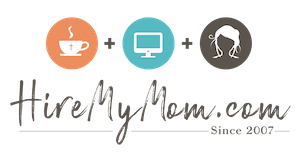What Moms And Small Businesses Are Saying About HireMyMom

There’s nothing more rewarding than hearing how HireMyMom has helped moms find meaningful, flexible work and how small businesses have discovered reliable, skilled remote talent. From job seekers who gained confidence and landed their dream roles to employers who found the perfect fit for their team, these stories remind us why our community is so special.
What Small Businesses Have To Say
“I used HireMyMom’s Concierge Service to hire my most recent position and it was a wonderful experience – worth every penny! Tesia was great, and having someone handle the administrative side of the hiring process took a huge load off my plate. Additionally, her recommendations and insights were really helpful, and it helped me to be able to talk with her as I made my decisions. Finally, she brought several excellent candidates to the table, which allowed me to have options and ultimately helped find the right person for the role – which we filled in about a month. All in all, I would highly recommend HireMyMom, and I will be using them for my next hire!”
– Jen B.
“We needed strong candidates desperately for an internal bookkeeper role. We saw great traction and really high-quality candidates from HireMyMom. We were extremely impressed with not only the pricing, but the entire process. It felt super easy and seamless to use as a hiring manager, and we appreciated the access to solid US-based talent without the usual noise. We will be back! Thank you!”
– Mona A.
Ready to find your dream candidate? Then post a job on our site!
What Moms Have To Say
“Three years ago a personal training client of mine informed me about HireMyMom.com. It could not have been a better time in my life as I was a single mom approaching a new schedule and the fact that I would have 3 kids in 3 different school schedules. A 9 to 5 would have never worked for me financially, professionally or personally. Within the first month with Hire My Mom, I had a great job with an eCommerce based company in California and worked for them for 2 years. Then later seeking a new position, Hire My Mom was my first go to and I found another perfect fit. Again, within a month with Hire My Mom, I signed up with another great remote position and could not be any happier. I highly recommend Hire My Mom in the search for your next venture. I am two times happy and very thankful for an organization that values a work/family balance. I honestly do not know how I would have been able to pull off the last 3 years without their amazing remote job hosting platform. Thank You!!”
– Jenny B.
“After months of trying to find a job through Indeed I found a job in less than two weeks with Hire My Mom! I have told so many other moms about it. I absolutely love this company and feel so blessed to have found them.”
– Melissa C.
“I was employed in an office job for 10 years. It was time for a change. Given that I was employed, I had the benefit of waiting for the right position. After interviewing for a couple positions that were a close fit but not quite “THE JOB,” HireMyMom recommended I apply for a newly posted position. My job experience wasn’t exactly what they were looking for, but it was a field I had always wanted to work in. I went for it!! After a couple weeks of the hiring process, I got the job! It’s been almost two months and I still feel like I’m dreaming. I work from home, making generous pay, in a position with an incredible team. This has completely changed my life. Go for what you want! Be picky! The right position is out there waiting for you!! HireMyMom can help you find it”
– Leigha T.
“Best Legit work from home job site! I joined hiremymom on the free trial in October, the last day of the free trial I applied for 3 jobs. I got an interview 2 days later & got my dream job! I’m going from being a corporate momma to an all virtual momma. My daughter’s school is going all remote and I’m just so grateful to be able to be there for her and still be employed. I am just so blessed to have found hiremymom on instagram!! They truly make it possible for moms that want to work, but also be able to be present for their kiddos!”
– Judith R.
Ready to start your own success story? Explore flexible remote opportunities and join a community of moms landing jobs they love.
Every testimonial is a reminder that meaningful work and reliable talent can be found in one place. Whether you’re a mom looking for flexibility or a business searching for trustworthy remote help, HireMyMom is here to make the process simple, supportive, and successful. Your next opportunity or your next great hire is just one step away!


